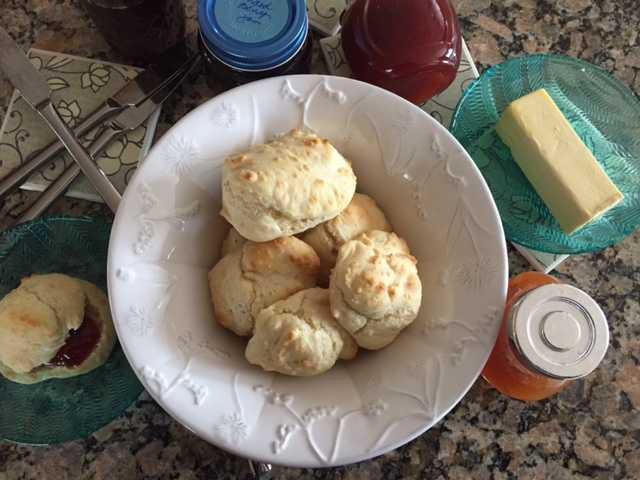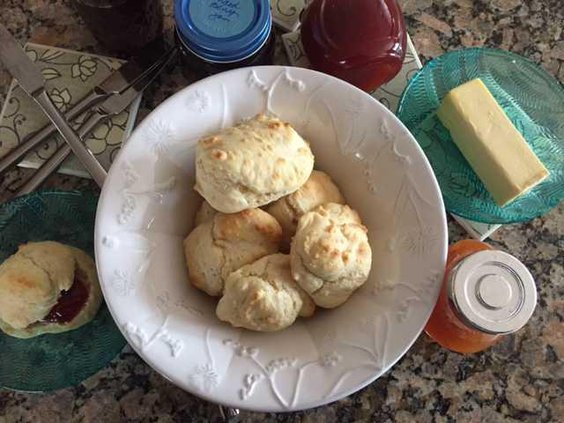There is a crazy thrill in finding a vintage recipe. It's a window into a simpler lifestyle, one free of fast food, nuked frozen meals, instant this or suddenly that. Equally, there is self-therapy in adding a few pantry items into a large mixing bowl and watching a transformation while stirring.
Vintage soda biscuits, an 81-year-old recipe, calls for "sour milk." In our day, this equates to buttermilk. In our great-grandmother's world, it meant taking one tablespoon of vinegar or lemon juice, then adding in fresh milk to complete a full cup measurement. It's a bit magical in the blink of an eye, the milk begins to curdle or "sour."
While tempting, don't skimp in following each basic step in preparation. Sifting is important. Using a pastry blender quickly unifies the dry ingredients with the small amount of butter listed. When preparing these for the first time, note that altitude can vary cooking times and may require adding or subtracting flour. This recipe is adapted from a 1936 edition of "Western Cook Book," compiled by Kay Morrow.
***
VINTAGE SODA BISCUITS
Servings: 8
1 cups flour
teaspoon salt
teaspoon sugar
teaspoon baking soda
1 tablespoons butter, shortening or margarine (I recommend butter), room temperature
1 cup sour milk or buttermilk
Sift together all dry ingredients into a large bowl: flour, salt, sugar and baking soda.
Using a pastry blender, cut in butter to the dry ingredients, making sure all have been well-mixed.
Slowly add in buttermilk, stirring with a large spoon or spatula. A soft ball of dough should form. If mixture is too wet, add in more sifted flour in small amounts.
Prepare cookie sheet or baking pan with cooking spray. Spoon drop (as you would cookies) 8 rounds of dough, separating them evenly on the pan.
In 475 degree oven, bake 12-14 minutes until the edges are a light golden brown, then serve with your favorite jam, jelly, honey butter, soft cheese or, even better, gravy.
Vintage soda biscuits, an 81-year-old recipe, calls for "sour milk." In our day, this equates to buttermilk. In our great-grandmother's world, it meant taking one tablespoon of vinegar or lemon juice, then adding in fresh milk to complete a full cup measurement. It's a bit magical in the blink of an eye, the milk begins to curdle or "sour."
While tempting, don't skimp in following each basic step in preparation. Sifting is important. Using a pastry blender quickly unifies the dry ingredients with the small amount of butter listed. When preparing these for the first time, note that altitude can vary cooking times and may require adding or subtracting flour. This recipe is adapted from a 1936 edition of "Western Cook Book," compiled by Kay Morrow.
***
VINTAGE SODA BISCUITS
Servings: 8
1 cups flour
teaspoon salt
teaspoon sugar
teaspoon baking soda
1 tablespoons butter, shortening or margarine (I recommend butter), room temperature
1 cup sour milk or buttermilk
Sift together all dry ingredients into a large bowl: flour, salt, sugar and baking soda.
Using a pastry blender, cut in butter to the dry ingredients, making sure all have been well-mixed.
Slowly add in buttermilk, stirring with a large spoon or spatula. A soft ball of dough should form. If mixture is too wet, add in more sifted flour in small amounts.
Prepare cookie sheet or baking pan with cooking spray. Spoon drop (as you would cookies) 8 rounds of dough, separating them evenly on the pan.
In 475 degree oven, bake 12-14 minutes until the edges are a light golden brown, then serve with your favorite jam, jelly, honey butter, soft cheese or, even better, gravy.








